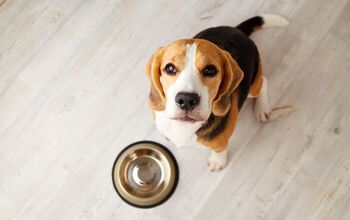How To Tell If Your Dog Is Underweight

Dogs love to eat – and that is no secret. Puppers of all breeds and sizes are well known for their big appetites and will often eat anything that they can get their paws on. Of course, that isn’t always the best thing to allow. Too much food and your doggo can quickly turn obese and unhealthy. But – big appetites are not the only end of that spectrum. Dogs can develop issues that severely limit their appetite. A dog that does not eat enough can soon become underweight – a state that puts big risks on their wellbeing. Sometimes, it’s the owners who are to blame – trying to introduce a diet in their pet’s routine, without consulting a vet, can turn into a bad scenario in the blink of an eye.
Once your doggo is critically skinny, it is imperative to bring them back to full health as soon as possible. But how exactly do you know when your dog is underweight? Luckily, there are some clear indicators that are easy to observe in every dog breed. One of the first, logical steps to take while examining your dog is to feel their ribs. You should first stand your doggo and then run your fingers across the side of their body. Usually, the ribs should not be pronounced, and are often covered with a healthy layer of muscle and tissue. Still, they should be felt only a little. When you cannot feel them at all, and there is too much fat covering them, it is a good sign you have an overly chubby doggo. But when the ribs are visible, easy to feel, and very pronounced, it is quite likely that your dog is underweight.
Another good test is the overhead look. While your dog is standing in the normal stance, take a moment to have a clear “bird’s eye view” of their contours. Jutting hip bones, an extremely narrow waist, a pronounced rib cage, and a clearly visible spine are all the bad signs you don’t want to see. If you do – your pet is underweight. You can also take a side look and observe your dog’s profile. The clue lies in their abdomen, which should usually be higher than their ribcage. Still, if this incline is too steep, and your dog’s abdomen is dangerously close to their spine and hips, it is a clear sign of a critical underweight condition.
If you do happen to conclude that your pet is underweight, you should bring them to your vet. With proper professional advice, some new important lifestyle changes should be implemented for your dog – mainly related to their diet. It is crucial to remember that loss of weight can come from some serious underlying health issues. Apathy, lethargy, and depression in dogs can lead to rapid weight loss and can indicate that something is quite wrong. If you notice this, a vet’s help is key to recovery. Nevertheless, it is good to know that this is an issue that is fixable with just a bit of patience and a healthy diet.

A proud mama to seven dogs and ten cats, Angela spends her days writing for her fellow pet parents and pampering her furballs, all of whom are rescues. When she's not gushing over her adorable cats or playing with her dogs, she can be found curled up with a good fantasy book.
More by Angela Vuckovic























